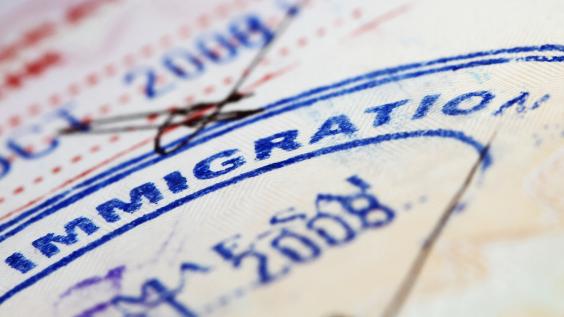Linking Immigration, Economic Opportunity, and the Rule of Law in Mexico and Central America

Table of Contents
Author(s)
Share this Publication
- Download PDF
- Print This Publication
- Cite This Publication Copy Citation
Payan, Tony. 2021. Linking Immigration, Economic Opportunity, and the Rule of Law in Mexico and Central America. Policy Brief: Recommendations for the New Administration. 01.27.21. Rice University’s Baker Institute for Public Policy, Houston, Texas.
Tags
This brief is part of a series of policy recommendations for the administration of President Joe Biden. Focusing on a range of important issues facing the country, the briefs are intended to provide decision-makers with relevant and effective ideas for addressing domestic and foreign policy priorities. View the entire series at www.bakerinstitute.org/recommendations-2021.
Introduction
Although dealing with the coronavirus pandemic and the resulting economic crisis may be top priorities for the Biden administration, an assessment of key immigration issues facing the United States should follow right behind. Essentially, recent developments on the ground and the Trump administration’s approach to immigration have resulted in an inhumane and ineffective system as well as immigration flows that are disadvantageous to the United States. This brief lays out some of the issues for the Biden administration and offers some recommendations to make immigration work for America.
Where We Are: Recent Developments and Policy Changes
Starting in 2014, migration patterns to the U.S. southern border changed dramatically. Instead of individuals or small groups of migrants trying to breach the border between ports of entry, most detentions were of family units and unaccompanied children, many of whom were fleeing dire economic and public safety conditions in their home countries and turned themselves in to U.S. authorities asking for asylum. This phenomenon, known as the “caravanization” of migration, has sometimes consisted of groups of thousands of persons trekking through Mexico up to the U.S. border. Primarily Central Americans, these caravans have also included people of other nationalities in South America, Africa, and the Middle East.
The image of migrant caravans moving through Mexico to the U.S. border was exploited politically in the United States, allowing Donald Trump to use immigration as a political platform as a presidential candidate and, once in office, to implement draconian changes to immigration policy in the name of preventing migrants from reaching the United States.
The Trump administration sought to restrict immigration altogether through a number of actions: by implementing travel bans; targeting humanitarian flows—including refugees and asylum seekers; separating and detaining families and children to deter them from coming to the border; expanding the definition of deportable aliens; forcing migrants to wait out their immigration court cases outside the U.S., through Asylum Cooperative Agreements (ACAs) with Mexico and Central America; tightening eligibility qualifications for legal migrants; restricting the Temporary Protected Status (TPS) program; reducing the number of non-immigrant visas; and challenging the Deferred Action for Childhood Arrivals (DACA) program; among other measures.
None of these actions constitutes a permanent solution to dealing with the immigration challenges the United States faces in the 21st century, particularly regarding their international dimensions. Nor do they constitute a path to making immigration policy work for the U.S. economy or demography in the long term. The following section lays out some key issues to be addressed by the new Biden administration and makes some recommendations focusing on immigration as both a domestic and regional issue.
Key Challenges to the Biden Administration: The Domestic Front
Undoing the Trump administration’s changes to the immigration system should be a priority for the Biden administration. These include restoring and expanding the immigration court system to deal with old and new cases; pushing for the passage of the Development, Relief, and Education for Alien Minors (DREAM) Act through Congress; restoring and expanding the TPS program; reviewing visa limits; resuming the Refugee Resettlement Program; easing the qualifications for legal immigration; and ending the family separation practices of Immigration and Customs Enforcement (ICE) by again making good on the 1997 Flores Settlement Agreement.
Although all these changes should be reviewed carefully, and most of Trump’s actions reversed, special emphasis should be placed on the U.S. immigration court system. It has some 460 judges, adjudicating hundreds of thousands of cases per year. In 2021, the case backlog now extends to almost 1.3 million cases. Some of the Trump administration’s changes to the court system, along with the COVID-19 pandemic, have worsened both the backlog and wait times. Court wait times are now averaging over 800 days. The Biden administration should double the number of immigration court judges and staff to reduce the backlog and ensure the courts reach merit-based decisions and expeditiously hear new cases. Cases should not be adjudicated in groups, as has become a norm in the last few years; each case must be decided on its merits.
A Regional Approach to Immigration: The International Front
Perhaps counterintuitively, the immigration system in the U.S. must be addressed as a regional issue that involves Mexico and Central America. Indeed, dealing with immigration today requires a regional approach to development and legal and orderly human mobility frameworks for all workers in North and Central America. Below are suggestions that can contribute to this approach.
Addressing the Push Factors: Creating Opportunity and Reducing Violence and Crime
The most serious immigration challenge today is presented by the caravans of thousands of migrants that have come and gone in waves over the past six years. This phenomenon obligates the new Biden administration to examine the immigration challenges of the United States through the lens of the economic hardship, crime, and violence that have devastated Central America and vast parts of Mexico. These “push factors” must be comprehensively addressed as economic and institutional development issues that are overwhelming this geopolitical area. A major development plan for Central America must not only include a broad commitment by the United States but must also include contributions from Mexico, as well as the private sector’s willingness to invest in job creation in that region.
Establish New and Orderly Ways for Central Americans to Work in the United States
The Biden administration should also restore and expand the TPS program for Central Americans and increase the number of visas to create new legal and orderly paths for Central Americans and Mexicans to work in the United States. This should include the facilitation of temporary employment visas processed in the workers’ home countries and assistance from the U.S. government to enter the U.S., work here, and safely return home when the visas expire. Key sectors that employ migrant workers and stand to benefit include construction, agriculture, food processing and services, accommodation and hospitality, domestic work, and manufacturing. These visas should be indexed to the shifts in U.S. labor market conditions.
Reviewing Mexico’s Approach to Transmigration
The Mexican government is key to addressing immigration in the region. The Trump administration’s approach forced Mexico to engage in a flagrant violation of the rights of many migrants through arbitrary detentions, unsanitary conditions in its detention centers, and an absence of due process for asylum seekers. The U.S. must continue to work with Mexico, but under a different approach. First, it should ensure that Mexico guarantees the humane treatment of all transmigrants and respects the human and due process rights of all migrants. The Biden administration must also coordinate with Mexico to ensure the orderly and expeditious passage of asylum seekers and refugees and move to process migrants stranded in Mexican border cities. Each of the migrants deserves their day in court. They should be returned humanely if they do not qualify for asylum or be handed over to the Office of Refugee Resettlement if they do. Finally, the Biden administration should ensure that Mexico and the United States invest in border infrastructure at the Guatemala-Mexico border in order to promote legal and orderly human mobility.
Rule of Law and Immigration
These recommendations are made with an eye to ensuring that the rule of law and respect for human rights prevail in immigration policy and that immigration is finally redefined as both a domestic and regional issue, through which the root causes of migration are addressed and orderly and legal human mobility is restored.
This material may be quoted or reproduced without prior permission, provided appropriate credit is given to the author and Rice University's Baker Institute for Public Policy. The views expressed herein are those of the individual author(s), and do not necessarily represent the views of Rice University's Baker Institute for Public Policy.



